Toppling Statues
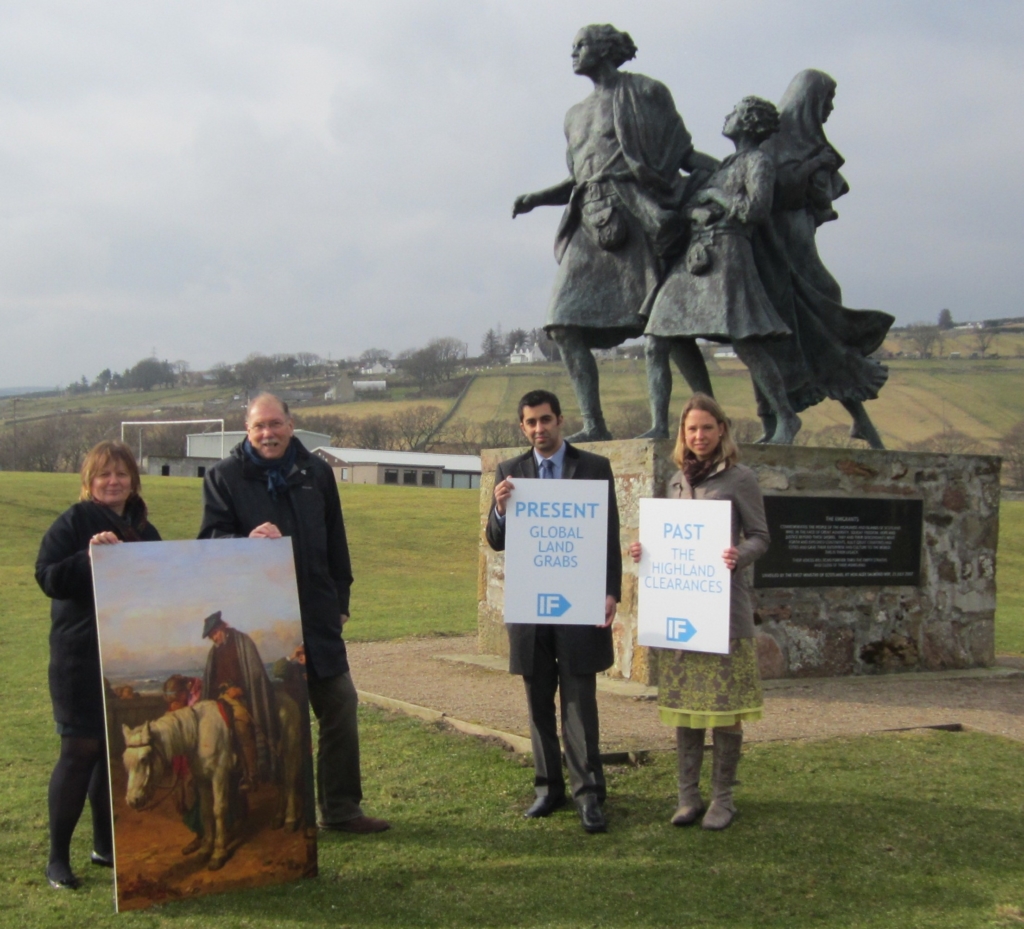
By 1994, five years after the fall of the Berlin Wall, many communist ‘hate figures’ had their statues demolished, some smashed to pieces, other re-erected in memorial gardens. In Scotland, for a decade, Highland Heritage Educational Trust had been campaigning to ‘keep the people’s history in the public eye’. This included publishing the Highland Clearances Trail to counter the history fed to generations of the view from the castle and factors’ windows. Two of our old campaigners Sandy Lindsay and Peter Findlay hit on a ploy. They applied for outline planning permission to remove the Duke of Sutherland’s statue from Ben Bhraggie which overlooked the ancient ducal seat at Dunrobin.
The Duke’s stony stare over the Moray Firth turns its back to the county from which thousands of Gaelic speaking, indigenous people were cleared to install sheep ranches. This improvement would accrue vastly increased estate revenues. ‘Golspie’s lordly stone’ was described in a more recent popular song Grannies Heilan’ Hame. It had been claimed, at the time of the monument’s completion in 1838, to be the largest portrait statue in Europe. For 150 years its place in the local landscape earned the sobriquet ‘The Mannie’ by the residents of Golspie and around. As time passed its prominent position atop Ben Bhraggie became a local fixture.
But an upswell of social history in the 1960s amplified a darker tale. Youngsters in north-west Sutherland and their crofting families recalled how their forebears had been ejected from the fertile inland straths to patches of heather to break in as crofts on the rugged coasts. Such gloomy memories were written up by the exiled Donald Macleod, who had witnessed the Rossal Clearance in 1813. Folk memories prompted a wave of support to topple the stone Duke when Lindsay and Findlay announced their plans in October 1994. In fact, the publicity provoked a worldwide clamour for removal and a trenchant debate that lasted far beyond the rejection by the Sutherland divisional planning committee of the plan in March 1996.
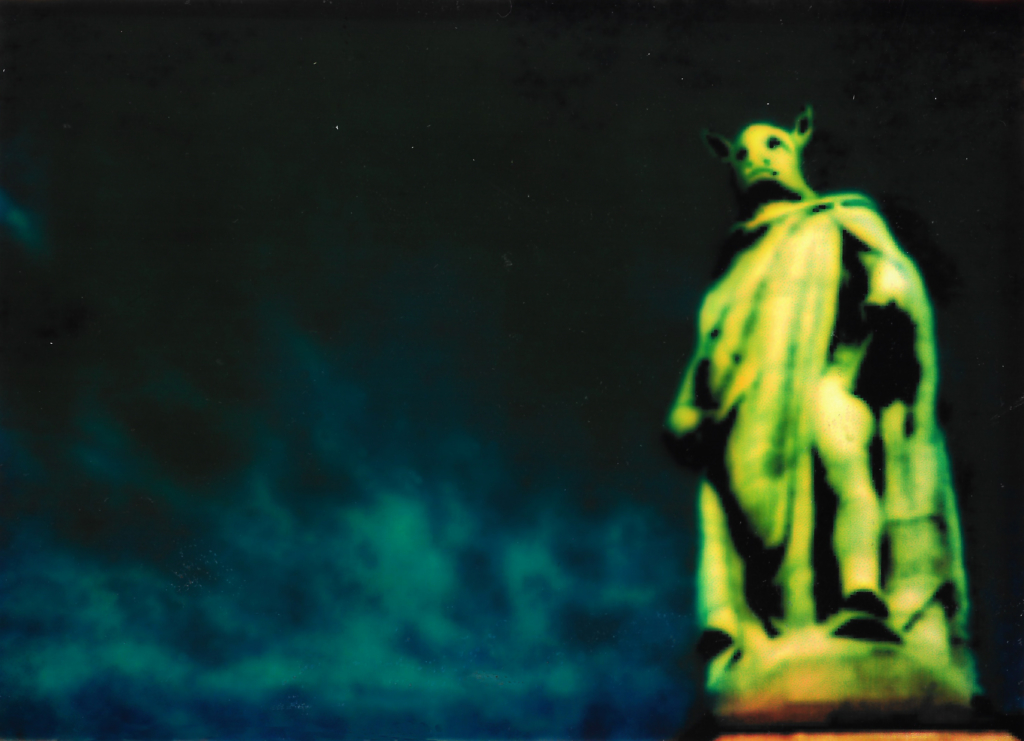
Highland Heritage members set up a specific group ‘The Book of Ben Bhraggie’ to gather signatures and funds for the demolition. Talk of blowing it up or dragging it down with ropes was pub talk for years. On seeing the ten metre white stone statue on top of a massive twenty mete red sandstone, plinth, they baulked. Recently persons unknown had cut the lightning conductor and from time to time a police presence was evident on the four hundred metre hill.
Lindsay and Findlay envisaged the statue’s careful removal and its re-erection in the formal gardens of Dunrobin Castle. They saw it replaced by a Celtic cross to symbolise a peaceful resolution. Three years later, An Lanntair museum in Stornoway curated an exhibition ‘MacTotem’ where thirty artists made ‘amendments, interferences, interventions and ideas’ around the infamous statue. One proposal placed a cage round his head, another replaced the head with that of a sheep (see above, image by David Hutchison). A friend of mine locally suggested placing a noose round its neck and holding that aloft by a helium balloon.
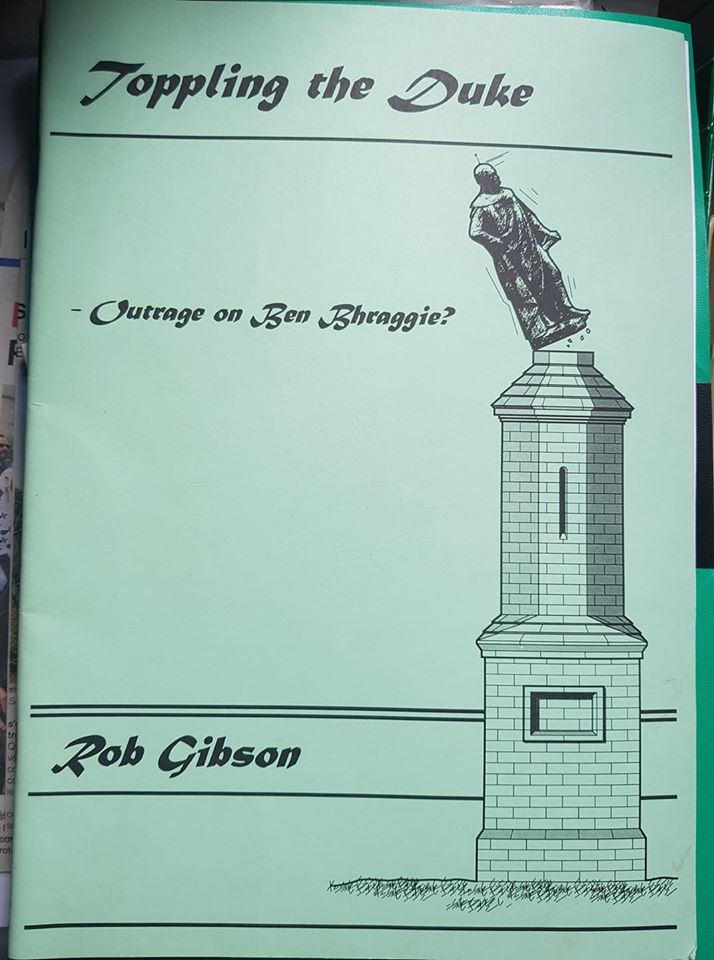
The truly lasting solution was proposed by Dennis MacLeod, a successful mining engineer, recently returned to Scotland after decades to live at Skatwell in Strathconon near Dingwall. Dennis had been born on a croft at Marrel by Helmsdale, of a family whose ancestors had been cleared from the Strath of Kildonan. A fortnight before entering the debate, on 18th October 1994 a large party of supporters of the Book of Ben Bhraggie climbed the hill and taped planning notices on the statue’s plinth. Dennis argued that it would be better to erect a new statue to those who suffered clearances featuring ‘a Highlander looking out to sea with his wife behind, looking back to the strath from which they had been cleared, with their two bairns at their side’. He also suggested a clearances museum with lists of those evicted, gathering records from around the world to make a huge archive. One outraged reaction was this was a waste of money, others were enthused at the prospect, offering their own ideas.
No one would deter the millionaire from choosing how to spend his money. He had previously funded clearances exhibits at the Timespan Museum in Helmsdale. His heritage included as a schoolboy running up Ben Bhraggie twice a week from Golspie High School. He had the means and the will to succeed. Circumstances led Dennis to commission sculptor Gerald Laing to create the new Emigrant’s statue. One was unveiled at Helmsdale in July 2007 by the then First Minister, Alex Salmond and the twin was unveiled in the following year in Winnipeg where cleared Kildonan folk had settled in the Red River Valley. Dennis, who had left the Highlands for health and family reasons, endowed the chair of history in the new department of the University of the Highlands and Islands based at Dornoch, in sight of the Duke’s statue. This led to the UHI appointing Jim Hunter as its first history professor. Jim’s series of books on the Clearances and the people’s fightback are central to modern scholarship which countered the establishment views that dominated the academic histories of the Highlands by the likes of TC Smout, Rosalind Mitchison and Phillip Gaskell. These had been standard texts when I entered university in 1968.
The ancient Earldom of Sutherland experienced the shock doctrine of improvement around 1810. For decades previously plans laid by the Countess envisaged greater rents to be extracted from tenants through sheep farming, which was then deemed compatible with existing local communities. Her marriage in 1785 to an English aristocrat, George Granville Leveson Gower changed everything. ‘The alliance of Lady Sutherland with the Stafford family brought together an exotic combination of Highland acres and English industrial wealth,’ wrote Eric Richards, the premier historian of Sutherland family. Gower had been in government, as joint postmaster general alongside Henry Dundas, the war minister. He had inherited wealth from huge farming estates and then canals and railway development in Midland England.
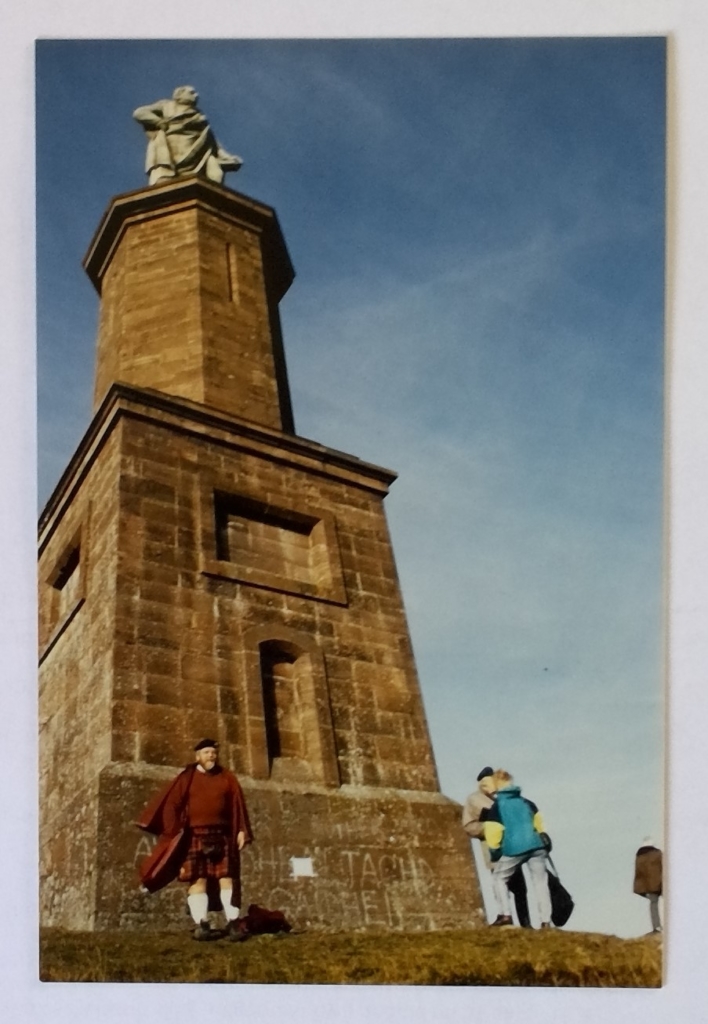
While no direct link is obvious between the Duke of Sutherland and slavery, the impact of his agents and sheep tenants led by Moray businessmen William Young and Patrick Sellar brought about the violent dispossession of Gaelic speaking natives.
There are now copious records of Highland lairds’ part in West Indian slave plantations, some from before the British Empire in 1707 in Dutch Suriname. Others directly invested their profits in sheep ranching which led to the eviction of local people here.
My home place, the village of Evanton in Easter Ross, reveals the local inheritance of both the slave trade and of the clearances. Street names celebrated slave plantations connections to Jamaica and Grenada while the same records show slaves given names local place names like Kiltearn, Foulis and Fyrish. In the 1880s Major Randall Jackson purchased nearby Swordale, Clare and Strath Skiach. In return for vacant possession to create a deer forest, he employed those dispossessed as servants and estate workers. On being elected to the new Ross-shire County Council he laid out allotments near the village for the remnants of an ancient civilisation which had populated the strath for millennia. Additionally, Jackson generously endowed the Diamond Jubilee Hall in which his portrait hangs to this day. The details of his part in the clearances of the Strath Skiach are not forgotten.
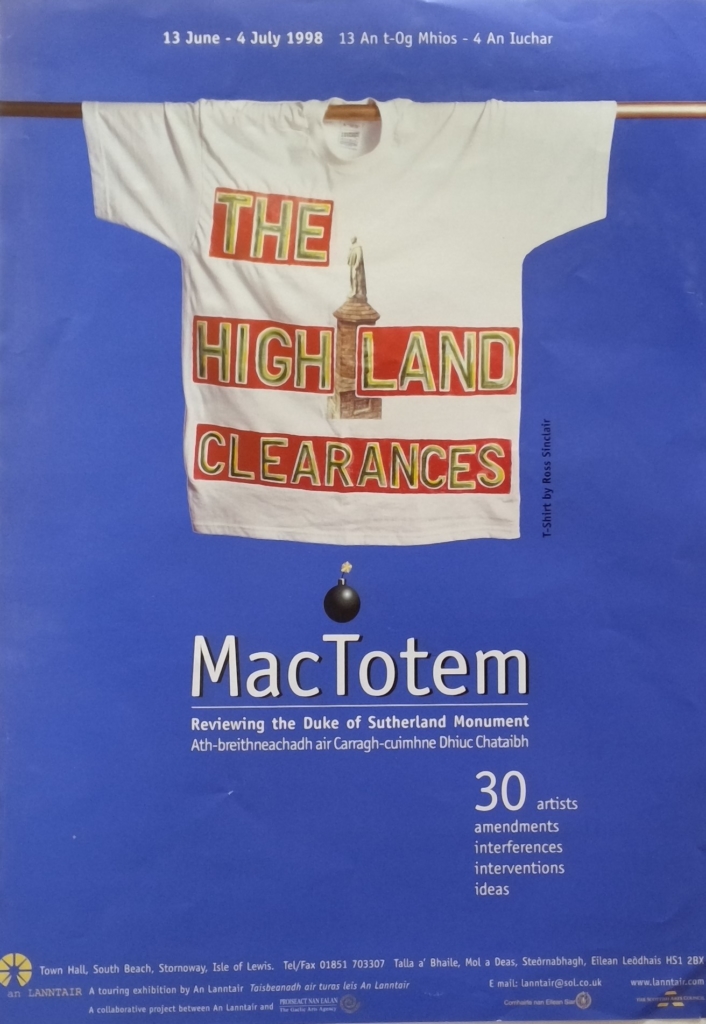
How we approach the education, the interpretation and the legacy of these slave owners and clearing lairds is a vital debate to rebalance our citizen’s knowledge of their country. I required to correct a letter writer from Golspie this week to The National. The writer stated that Sandy Lindsay has applied to demolish the Duke’s statue and break it into pieces and scatter them on the hillside. In fact, it was Neal Ascherson who wrote in his column in the Independent on Sunday on 9th October 1994 under a headline ‘Blow up the Duke of Sutherland but leave his limbs among the heather’. He argued, “I would blow him up, not just as a statement about the Clearances but as a gesture about ‘Heritage’, for the Duke’s removal is a reminder that Heritage, after all, is not just a dry schedule of monuments. It is a ceaseless rolling judgement by a people on its past.”
Black lives matters, repopulating the Clearance lands matter, we must get these tasks in hand.
Notes:
Rob Gibson, Toppling the Duke – Outrage on Ben Bhraggie? Highland Heritage Educational Trust, 1996 and Strath Skiach, the Hawthorn Valley, Clan Munro Magazine no.26, 2012
Eric Richards, Patrick Sellar and the Highland Clearances, Edinburgh University Press, 1999
James Loch, Esc.MP, Memoir of the First Duke of Sutherland KG, printed, not published, 1834
Rosh with Adrian Clark, Evanton – Built on Slavery? Facebook 9th June 2020
Prof. David Worthington, The Highland slave owners in 17th Century South America UHI Centre for History.

This is brilliant. What is needed is to extension the idea into modern ideas of how to do this. I made a very careful study of how to do it. I got a horrible, hate filled reaction from various people, most of whom were heavily anglicised “Scots”. Franz Fanons “Black Skins, White Masks” comes to mind. Anyone that tries to tell the truth about Scotlands past gets this. A lot of Anglo academics were of course, totally hostile. also, “Officials”. You mut not disturb, in any way, the graves, the lands, of a massive genocide, which has been hidden behind anglo historians for centuries. The present Genocide of the Palastinians is a classic example of the way it is done. exactly the same tactics were used in Scotland. ,A genocide is a genocide. slow or fast, the eradication of the indigenous is a genocide, in the strict sense of the word. So we start from that. following this genocide, there was an ecocide, with everything being cleared for sheep grazing and exploitation. The forests cut and felled and replaced by open desolate moorland. The present landscape of the highlands, is totally unnatural, it is one of the biggest ecocides in Europe.
So what is to be done?…firstly, the Government in Edinburgh to pass a law of “Eminent Domain”, that all land is ultimately the possession of the state. All land titles are to be derived from that. One investigation I made was that a certain western estate of some 80,000 acres was yielding, for tax purposes, a gross profit of about £12,000 a year, (yes, this really is true). They paid no taxes on this. nobody was allowed to use th estate for anything useful, being given over entirely to shooting and hunting. nothing was allowed to be done. Eminent domain means that the Goverment is able to seize land for the “Public good”. Under EU law, (now being removed) and Scottish law, compensation is due. its based on the actual value of the land, which is rated at 20 times its annual taxable profit. In this case, zero.
So what is to be done, with such Land seizure?. I point to Zimbabwe, where the white settler properties have been seized. they were given over totally to tobacco, and and were useless for feeding the people. However, the lands were distributed to families for useful farming. however, no funds were allocated for training, developing crops, or markting. the result was the subsistance semi-starvation agriculture that existed in Ireland until about a hundred years ago. Ireland now has a huge agricultural output. The Scottish solution is simple. lawful seizure, and redistribution by leases to families, under the present Cuban land laws, as leases. Plus a land bank. also microforests, where the land is divided equally into small forests, clustered around small areas of say 20 to 100 farms. of about 50 acres each. with known organic land restoration, these would prosper. the output would be about twice that of Ireland. The forests would be collectively run, by the local communities, with profits distributed by labour input. many jobs would be created. several hundred thousand people, over say 50 years, would be resettled. Gaelic language areas would be encouraged. This is called REVERSING GENOCIDE. Some of the profits that are taxed, wuold use the revenues to run the extensions of the schemes. We are talking about 100 years here, for it all to reach saturation, but in 30 years, substantial forests and farms programs, would make the profits unstoppable. I await the usual ignorant criticism, opposition founded on aglocentric ideology, etc etc. or probably, there will just be an utter silence, a silence continued from that of the million gaelic dead, deported, killed in the hidden Scottish famine that followed the Irish one. Comments, please. This debate has to be had, and on here.
Your comment resonated with me, since I have just read Guy Standing’s book ‘Plunder of the Commons’ (Pelican 2019). Subtitled ‘A Manifesto for Sharing Public Wealth’, he proposes a Charter of the Commons.
Much of what you propose resonates with the idea of the commons, and should be recognised as a fundamental policy of the independence movement; I may not necessarily agree with all the details of your proposals, but would absolutely support the general principle.
There are potential areas of tax which could help resolve the distorted land ownership resulting from historic land grabs and clearances. I believe these are within the remit of the devolved Scottish Government and could be introduced under section 80I of Scotland Act 1998 (as amended).
Annual Ground Rent or Land Value Taxation (AGR) should be introduced, tied to the fixed land asset in the National Land Registry which can’t be hidden in offshore accounts. It could end land being used for speculative investment and tax avoidance. The AGR could be reduced, or even a subsidy provided, to help support farms meeting the best food quality, animal husbandry and ecological standards. It could also help initiate logistics set ups so customers can connect to local farmer suppliers and associated local retailers. These could all help counter the import of low standard foods full of chemical preservatives etc. including in trade deals with the USA.
The tax income could help support good ecological, carbon capture, environmental standards including managed indigenous forestry. It could also support training and increased employment in agriculture and forestry.
The Land value tax should be set at a level to more than pay for the costs associated with the Covid 19 pandemic and be shaped to overturn the distorted land ownership in Scotland and make our land ecologically sound and productive for the benefit of the people of Scotland.
Morning Jim,
Some good ideas which deserve fuller investigation. But, I’d go further and make it a legal requirement that owners of Scottish land above x hectares must reside with a permanent address in Scotland and I’d give them five years to comply with failure to do so results in forfeiture, call it ‘reverse clearances’. Seem to recall that after 1922 in Ireland large estates were broken-up and farms sold back to locals with some financial help from the new Irish Government (Someone with more knowledge of this could perhaps confirm/correct)
The Irish Land Commission was set up in 1881, under one of (Gladstones?) Land Acts, to redistribute land from estates to tenants to become owners (like the 2014 ‘Vow’, the Land Acts were an attempt to head off nationalism).
One if my great grand fathers (& g’grandmothers) was dispossessed x 2-3 years, & only regained ‘his’ farm through (I think the 1881) a Land Act. The scheme was funded by W’minister with 100 year loans, which were deemed paid up as part of the settlement of the ‘Land War’ in 1930s between De Valera’s Irsh Free State and rUK at that time.
I’m open to correction on all details, but if you look up ‘land commission (as I have just done), you could waste the entire afternoon.
Btw excellent post
Charlie I really like the idea of living in Scotland being a requirement.
Sadly ,”utter silence” is what you’re most likely to get. Everybody knows about the Clearances, but few Scots know anything about the details or the price exacted from those affected. In that sense, the Clearances remains as Scotland’s most closely guarded national secret. That the statue has been allowed to remain is merely an accompanying mystery. Scottish historiography will commence in the same hour that Scottish Independence becomes a living reality.
Land reform is critical. The basis of enslavement is to be found in the dispassion of the people from the soil. To tax the value of land is to shatter the monopoly of an oligarchy of families holding large tracts of land and increase the productivity and employment of labour. Landowners will be forced by the pressure of the tax either to use their land in the best possible way or give way to those who will. Land taxation is an economically efficient and ethical revenue source and a more secure tax base in the age of multinationals and tax havens.
Man is a land animal. We are blessed with a large landmass in Scotland. All of it belongs to the people of Scotland and all of it should be in possession of the state. I like the idea of passing a law of “ Eminent Domain “ as a radical way forward. Andy Wightman has been a passionate advocate of land reform but nothing changes. Why has the Scottish Government not achieved any progress on this? They seem to chicken out of any systemic changes to help oor ain folk to flourish and prosper on land which belongs to all who live in Scotland.
Unfortunately with the choice of people on the commission to look at the economic recovery after the Coronavirus land tax and land reform are unlikely to be on the agenda.
Excellent. Many thanks to you, Rob Gibson, and all strength to your elbow.
Doon wi the Mannie & Dundas replace both with large stone balls!
I agree that those whose place in history is that they destroyed homes, livelihoods and culture should not be celebrated, and a statue is a very visible form of celebration. The statues of those whom we now regard with shame and dishonour need to be removed from public gaze. By all means preserve the history and the part played by those people in it – in school education and in museums – but tell the whole truth in those establishments, including the suffering caused by those men and the use of their wealth and power for selfish and cruel means. We should certainly not forget them, but we should tell the whole story about them so that locals and visitors, from anywhere in the world, can form their own judgements about them, as I have done.
I like the sheep’s heid…..
Yeah, me too
So, why didn’t Neal Ascherson blow up the statue? Was he likewise waiting for planning permission?
I believe there have been several recent cack-handed attempts to topple the statue, which I suppose are, like the national football team we not only thole but actively court and squire in its aventuras around the world, emblematic of our heroic ineptitude. The whole Beinn a’ Bhragaidh affair is a disgrace and an embarrassment, not because of the subject of the monument, but because we’re owre thoomless ti dae ocht aboot it.
It’s also an embarrassment because the whole affair is so petty. Fair enough, I appreciate that, for a lot of folk, blood is thicker than water and that the land reforms in Cataibh, which Leveson-Gower effected at the start of the 19th century, caused grievous suffering to those further back in the bloodline. But 200 years is far too long to be continuing a feud, even as a race memory. As the Carinthian writer, Robert Musil, famously said: ‘There’s nothing in this world as invisible as a monument’.
So, my advice would be to stop drawing attention to it by continually picking over the sore and leave the monument where it is, subverting itself as a shameful testament to its time and the buggers who erected it. Who knows, maybe Frankie Egerton will be so black affronted by it that he’ll quietly take it down himself?
Neal Ascherson ?
Robert Musil (1880-1942), Austrian writer and opponent of Fascism, who had to leave his country. Wonderful quote. I wish I had thought of it. His masterpiece is the novel, ‘The Man Without Qualities’ (1930-33).
To designate Musil as an Austrian writer is tantamount to designating Irvine Welsh a British writer.
Musil was born in the Slovene city of Celovec and moved shortly after his birth to Chomutov, in Bohemia. Unable to cope with his pugnacious temperament as a teen, his parents send him to a military boarding school in Hranice, in Moravia. After his officer training, he went on to study engineering at Brno. He was as Austrian as Kafka was.
Following the collapse of the Austro-Hungarian Empire and the triumph of nationalism in his homeland, he exiled himself to Berlin. He was a staunch individualist, who opposed the collectivism of both the right and the left. A recurring theme in his speeches and essays through the 1930s is the defence of the autonomy of the individual against the identity politics then prevailing in the former European empires. In 1935, he participated in the International Writers’ Congress for the Defence of Culture, at which he spoke in favour of artistic independence against the claims of the state, class, nation, and religion.
Ironically, given the subject of this thread, it was the iconoclasm of the Nazis that drove him from Berlin to Vienna and thence to Zürich with his Jewish wife, Martha. The nationalists burned his books, which they found offensive and an insult to their bloodline.
Happily, the body of his work has been reassembled and is now curated by the Carinthian Literature Archive at the Robert Musil Institute for Literary Research in the Carinthian state capital of Celovec. This is in the process of being made freely accessible to the world through the Institute’s online portal. Meanwhile, links to the currently extant works, and to that of thirty-odd other Carinthian writers, are to be found in the Musil Museum’s Virtual Literature Lounge.
Meanwhile, we girn about invisible monuments… What a pathetic little people we are.
Well, I am both corrected and rebuked; although would I be “girning” if I said the collapse of the Byzantine Austro-Hungarian Empire during his lifetime does make it a little tricky for mere casual outsiders to parse the matter?
Perhaps we would all benefit if you wrote an article on Musil, and of the parallels to ourselves, which you have used to chastise us (I am not complaining; I daren’t), for our instruction – and submit it to Bella Caledonia. Musil is a wonderful writer* (I am ashamed to say I read him in English translation; I shudder to think what you will make of that), and although I have made some lighthearted cooments here, I would look forward to what I feel would be an education .
* He has that same elegant, refined, delicate and surgical method of slowly and wickedly deconstructing a personality, as his close contemporary novelist, the tragic Stefan Zweig (1881-1942), who was (and now I am shaking in my shoes) – an Austrian………..
Yes, Stephan Zweig was a bona fide Wiener, through and through; though, interestingly or not, he was loth to identify as one, as his autobiography makes clear. Like Nietzsche, he liked to think of himself as a good European, the norms and values of which would ‘overcome’ national or state identity. But I have my doubts.
Some of us, like the Swabian poet, Michael Hofmann, who (incidentally) spent part of his childhood in Edinburgh, aren’t entirely convinced of the sincerity of Zweig’s Europeanism. Hoffman attributed a ‘vermicular dither’ in relation to the renunciation of his national identity, and to his sensibilities generally. About ten years ago, in the London, Review of Books, he memorably wrote that Zweig tastes fake, just as Pepsi tastes of nothing but fake Coke; he even detected this inauthenticity in Zweig’s suicide note, leaving us with the sense that his heart wasn’t even in the taking of his own life, that it wasn’t ‘the real thing’. And the suspicion that his avowed cosmopolitanism wasn’t genuine is surely supported by the fact that Zweig, shortly before his suicide, complained in a letter to a writing colleague from the German colony of Petrópolis in Brazil, where his enforced odyssey had finally washed him up, that his inner crisis consisted in his being no longer able to identify himself with the person in his passport, the ‘self of exile’.
So, despite even his own claims to the contrary, Zweig was indeed an ‘Austrian’. The bottom line is that, despite himself, he failed to overcome his nationality, which is the real tragedy of Stephan Zweig.
You presumably have written something about this; it would be helpful if you provided a reference gor those who may wish to pursue this. Your description of Zweig reminds me of Hofmiller in ‘Beware of Pity’ (1939), whom he eviserates through the novel (and not to forget his own supposed Hitchcockian appearance in the novel as a novelist and almost professional ‘hanger-on’). I always wondered if the carefully choreographed, excruciating moral failures throughout the novel; but unnoticed by everyone present because they were all done to protect the conventions of a rigid society and his personal reputation. You describe even his suicide in the same terms. You are, if I may say, a little sever on him. I see only tragedy and feel only compassion. Nevertheless, thank you; very illuminating.
Since you have provided these insights and you have been so severe on what you have read, it is now incumbent on you to write about Musil, Zweig and their culture for a local Scottish audience.
“eviscerates”
In 1985, Andrew Kopkind, who wrote for a number of progressive publications in the US, made this observation in an essay for The Nation magazine:
“Peoples in the throes of liberation like to smash their icons, disavow their myths and begin to create new ideals and models. Societies bound to repressive authority, on the other hand, build ever bigger statues and adhere to stricter cults. “
Should read “I always wondered if the carefully choreographed, excruciating moral failures throughout the novel; but unnoticed by everyone present because they were all done to protect the conventions of a rigid society and Hofmiller’s personal reputation, were actually about Zweig himself”.
Apologies, it has been a long day, I have been writing a great deal on different fronts, and fatigue has set in; and the spell-check on ‘Pages’ is worse than useless. I have to correct it.
No, I don’t think I’ve ever written anything about Musil or Zweig before, and the last thing I expected, when I first commented on the vain Verschiebung evident in the iconoclastic sentiments that have been directed towards the Mannie, was to end up reflecting on them here. I also lack the application to write an article about anything; the last such positive article I wrote would have been in 1986, since when it’s been the sublations of negative dialectics for me. What I will do, however, is take the reading I’ve serendipitously articulated here and carry it, as my current Vorurteil, into further readings of Musil and Zweig, with a view to overcoming my existing understanding of their texts. That’s what really floats my boat: richer reading and the cultivation thereof. I haven’t read either of them for ages anyway.
Given your severity with others, from commenters to dead novelists, I suspect that apart from it being none of my business, my fleeting thought that your reading might be richer still if you shared your insights with others (it is not only a means to clarify your own thoughts, but is a gift to knowedge), will not be well received.
Reading your comments, while admittedly refreshing, I confess has something of the same effect as a large bucket of ice-cold water thrown abruptly in my face; in spite of which, I wish to thank you for your contribution; it has been bracing. Now, where did I put that towel?
Hi Germany does not have statues to Hitler outside concentration or extermination camps why do we have this statue to the Duke of Sutherland? At least take the man itself off the top of the huge plinth. Put him in the ground of Dunbobin Castle instead. His statue is too prominent at the top of a mountain. We should be celebrating people by putting their statue up somewhere not this atrocious man. There should also be a plaque attached to the plinth on the top of the mountain with the true facts about this man’s atrocities.
Hello Rob,
I’m doing some research on The Mannie and I hoped to climb it on Hogmanay and again on the 1st but was thwarted by flooding at Alness. Can you tell me if there is any interpretation / information about his role in the Clearances at any point on the walk to the summit? Many thanks
Michael Hart